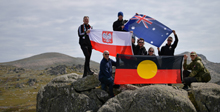
Photo K. Małek |
Sir Paul Edmund de Strzelecki died on October 6, 1873 in London at the age of 76. What legacy did he leave to justify the celebration of a year dedicated to him? His most famous achievement in contemporary consciousness is his ascent of Australia’s highest summit and naming it after Tadeusz Kościuszko. This basic knowledge seems to be common among educated people in Poland, at least at the elementary level.
A smaller cohort knows that Strzelecki was awarded the Gold Founder's Medal of the Royal Geographical Society for his comprehensive exploration of Australia published as The Physical Description of New South Wales and van Diemen’s Land (London, 1845) (Polish translation: P.E. Strzelecki, New South Wales, PWN 1958).
In July 2022, the Parliament of the Republic of Poland established 2023 as the Year of Paul Edmund Strzelecki
The resolution of the Polish Parliaments reminds us that not only was Strzelecki an outstanding researcher, and explorer, but he was also a great humanitarian, social activist and the first Pole who, for scientific purposes, circumnavigated the globe alone. Everywhere he traveled, he conducted geological research and published information about his discoveries. However, it was his exploration of Australia that brought him the greatest fame. Many geographical features in Australia have been named after Paul Edmund Strzelecki, and thus he has permanently entered its history. (...) During the Great Famine in Ireland, he was deeply involved in helping the starving inhabitants. He focused his activities on saving starving children of all Faiths. It has been well documented that he helped save over 200,000 children and countless adults.
How will we celebrate the Year of Strzelecki in Australia? A Celebration Committee was formed, which created an opportunity to coordinate occasional events organized by the Polish community in several states, mainly in New South Wales, Victoria and South Australia. Paradoxically the celebrations in Tasmania, formerly known as Van Diemens Land, where Strzelecki did most of his exploratory research, will probably be least active in celebrating the Year of Strzelecki.
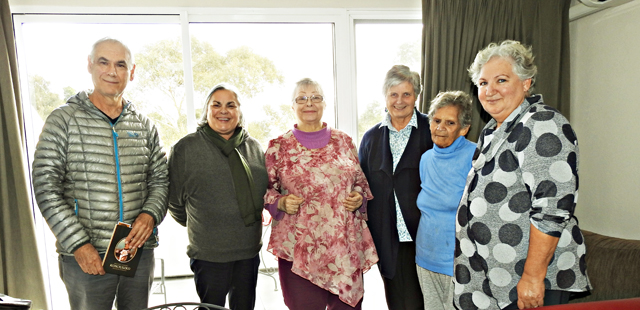
May 5th 2019. Jindabyne meeting. From left: Dave Darlington (KNP), Aunty Doris Paton, Ngarigo Elder, Ernestyna Skurjat-Kozek (KHI President), P.Darlington (KNP), Aunty Deannne Davison and Aunty Iris White, Ngarigo Elders |

Pennant Hills, May 26th 2019, signing a Joint Petition |
An international Strzelecki Year Competition has been organised with a post-competition gala. Celebrations will take place at the Strzelecki monument in Jindabyne, and at the other side of the Snowies, in Towong and Corryong. Activities will include Friendship Flights over Geehi and Mount Kosciuszko; the unveiling of another commemorative plaque honouring Strzelecki's route to the Snowy Mountains - this time in Towong; a Gippsland Rally visiting memorials dedicated to Strzelecki. The Year will close with a solemn Mass at the Sanctuary of Divine Mercy in Keysborough. Local photo competitions are planned, as well as performances in Poland by the Ngarigo choir, traditional custodians of Mount Kosciuszko. A visiting delegation from the Australian Polish community will participate in the celebrations in Głuszyna. Irish scientists have taken part in the anniversary ceremony in Sydney.
Mount Kosciuszko, the pearl of Strzelecki's discoveries, is now considered one of Australia's great tourist icons. It was a media hit for Strzelecki . He achieved it through a tangential route from his main exploratory route towards what is now Gippsland. For this climb of the highest summit of the Muniang - Snowy Mountains, the Strzelecki party hired a local guide, Jackie from a farm in Welaregang. He was from the Dhudhuroa tribe. For this tangential trek two permanent members of the expedition, remained on the Welaregang. Their temporary separation from the expedition for a period of about a week was very important. The shearing of sheep on the farm could not wait. Jackie, who was working on the farm was able to be spared to flawlessly lead at an excellent pace, the Strzelecki and Macarthur exploratory team. He knew well the paths of Aboriginal migrations, used to gather the Bogong moths from the highest parts of the Mountains.
Not only naming the mountain, but also its name was a 'bull's eye': in 1840, Poland, dismantled by Russia, Prussia and Austria, was not on the map, but the highest peak in Australia reminded the world that Poland was not lost. In 1940, the 100th anniversary of the naming of the Mountain, Poland had been invaded by both Germany and the Soviet Union and no longer appeared on world maps. Kosciuszko monuments were being destroyed in Poland. In defiant protest, Australian children from New South Wales donated their pennies to help fund a brass plaque which was solemnly unveiled at the summit of Mount Kosciuszko on the 100th Anniversary of its naming.
The Strzelecki Year celebrations are a great opportunity for Poland and the Polish diaspora to strengthen their image as a community open to mutual understanding and cooperation with other minorities of multicultural Australia, especially with the Aboriginal people of the Monero-Ngarigo tribe, the traditional custodians of Mount Kosciuszko. It should be noted, however, that this is not a path free of pitfalls and for multiple reasons.
The summit name introduced by Strzelecki has had its controversies. They stem from errors made not only by Strzelecki himself, such as the incorrect date made in his report to Governor Gipps (February 15, 1840 instead of March 12, 1840) but also errors made by others, later (1870), such as when surveyors from Victoria wrongfully placed on their maps the name of Mt Kosciusko at the summit of the present Mt Townsend. It is likely that this error stemmed from the fact that it is Mt Townsend and not Mt Kosciuszko that is visible as the highest peak from the Victoria side of the Snowy Mountains, from the Murray River near present day Corryong. The locals wrongfully believed that Strzelecki named the highest summit visible to them as Mt Kościuszko. The Victorian surveyors adopted this mistake and put name Mt Kosciusko at the place where the present Mt Townsend is located.
In 1885, 45 years after Strzelecki, Austrian researcher Dr von Lendenfeld, used this incorrect Victorian map and like Strzelecki in 1840 confirmed that the highest summit visible from the Victorian side of the Snowies was slightly lower than the nearby but invisible from the western side summit. He did not question the veracity of the Victorian Survey map, so he named the higher peak as Mt Townsend and broadly announced that he discovered the true highest peak of the Snowy Mountains. He asserted that it was Strzelecki who made the mistake by climbing the lower peak and naming it Kosciusko. The New South Wales authorities rejected his claims as on the NSW maps name Mt Kosciusko always was at the same loacation as it is these days. It may be interesting that it was Surveyor General Townsend who first put the name Mt Kosciusko on the official maps of NSW.
To honour the surveyor Townsend the NSW named the second highest peak of the Snowies, i.e. the highest peak visible from the Victorian side of the mountains as Mt Townsend. However Von Lendenfeld heavily promoted his ‘discovery of the error’ in the media, triggering false stories about the changing of names of the two mountains. But nothing of the sort happened.
It should also be noted that many inhabitants of the areas west of the Snowy Mountains continue to point to what is actually Mt Townsend, and identify it as Mt Kosciuszko. At Faran’s Lookout, the peak of Mt Kosciuszko is shown on the information board, the indicator points in the right direction, but that summit is not actually visible from there. Google Earth tools prove this. Confusion caused by von Lendenfeld remains. The eponym Kościuszko Range has been given to the range where Mt Townsend is the highest summit. Likewise, the names of Kosciuszko Creek and Strzelecki Creek are on slopes that are much closer to Mt Townsend than Mt Kosciuszko.
Nowadays Mt Kosciuszko is an easy climb, made so around 1904 by the construction to it of the road from Jindabyne and later in the 1980’s by the iron tourist path from Thredbo. Mt Kosciuszko became a tourist icon and a part of Australian identity. The name pronounced by Australians as Kozi-osko or Kozzie may suggest an Aboriginal origin. However, it is neither an Anglo-Saxon nor an Aboriginal name. This is probably why knowledge about the Polish origins of Paul Edmund Strzelecki and Tadeusz Kościuszko, a man who never set foot in Australia, is not easy to promote here. Nowadays, the world prefers to beat its breasts about settlers in former colonial countries and thus compensate for the suffering of indigenous peoples related to their undemocratic transition from their traditional culture to the current multiculturalism. Changing the name Kosciuszko to the root name or adding a double name to it becomes very attractive in some circles. This would ‘curry favour’ with indigenous peoples and at the same time get rid of the ‘unwanted’ foreign cultural intrusion. Two ducks killed with one shot. This is not new, for centuries popularity has been appropriated by the giving of gifts that did not belong to the donors.
Let’s recall other attempts to change the name of the Mountain, not just the turmoil associated with von Lendenfeld. We are talking about ‘currying favour’ with indigenous people. One of the oldest examples was the Targangil name in narrative associated with the famous Bogong moth, a traditional and very nutritious delicacy of local tribes. This narrative appeared for the first time in a letter from James S. Spencer to the Editor of the Herald (1885-02-18) correcting the fanfare of Dr von Lendenfeld sanctimoniously proclaiming that it was he who actually deserved the glory of climbing and naming the highest peak in Australia. Spencer writes that the indigenous people called Mt Kosciusko “Tar-gan-gil”, but given that he used names from faulty 1870 Victorian maps, it is evident that he meant the mountain now known as Mt Townsend. Nevertheless, it is worth realizing that in Charlotte Pass, Targangil Refuge still believe that Targangil is the Aboriginal name for Mt Kosciuszko and not Mt Townsend. It is certainly attractive in marketing terms.
Another incident that we came across happened during the celebrations on the 150th anniversary of the death of Tadeusz Kościuszko in 1967, organized in Perisher Valley by the Presidium of the Australian Polish Community Council and by the Cooma Chamber of Commerce. Andrzej Kleeberg was chairman at the time. An article appeared in the local newspaper, the Cooma Monaro Express, in which the author, on behalf of "Namatjira Fan Club", claimed that Strzelecki had never been to the Mountain, and Kościuszko himself was a Ned Kelly-type robber, and so demanded that Mt Kosciusko be renamed Targangil or Namatjira (Namatjira was a famous indigenous painter from Central Australia). This incident was rightly ignored.
The next, well-remembered and documented incident was the year 2000 speech of retired Tumbarumba Mayor, George Martin. Standing on Mount Kosciuszko in front of ABC television cameras and in the presence of Deputy Prime Minister Tim Fisher as well as the President of the Polish Council of Australia, Dr Janusz Rygielski, George Martin vilified Strzelecki as a "conman, a fraudster, and Kościuszko as a man whose foot had not even set foot in Australia" and that the name should be changed to something "more Aboriginal". Recall that George Martin claimed Aboriginal genealogy asserting that his grandmother's grandfather was from the Aboriginal Ngarrindjeri tribe of Coorong near the source of the Murray River. (We met George Martin for the first time in 2019 in Tumbarumba).
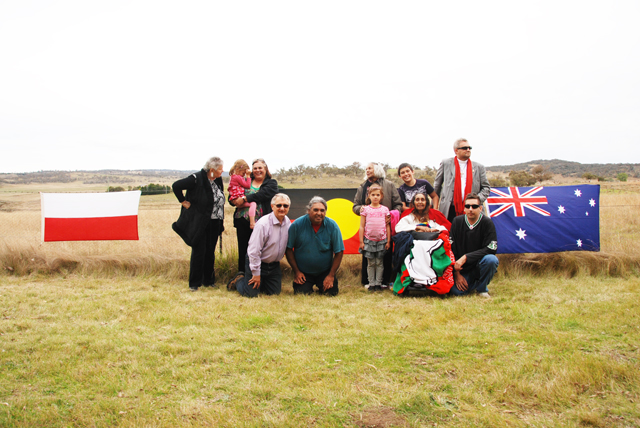
April 14th 2012, Moonbah Festival featuring Ngarigo families and Fr Wieslaw Wójcik (on right) |
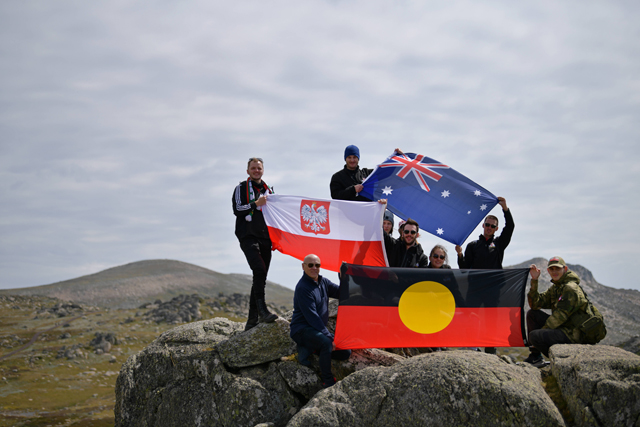
Lajkonik ecological expedition to Mt Kosciuszko, March 8th 2021 |
After George Martin's speech, the reaction of the Polish community was decisive. President Rygielski immediately published the report "Attack against Poland" in Tygodnik Polski, and in Western Australia, under the leadership of dr Anna Habryn, in 2002, the organization Mt Kosciuszko Inc was established, through the website http://mtkosciuszko.org.au/ which gained considerable popularity and to this day collects articles and reprints issues related to this 2000 event.
In 2005, dr Habryn conducted a press poll in which 93% of respondents expressed their opinion by telephone in favor of keeping the old name of Mt Kosciuszko (2237 callers). Let us also recall the bulletin published in 2005 by the Presidium of the Supreme Council of the Polish Communities under the editorship of the President Dr J. Rygielski devoted to Tadeusz Kościuszko and Mount Kościuszko as well as his speech in 2006 in front of the Productivity Commission of the Federal Parliament in Australia at a meeting on the Conservation of Historic Heritage Places.
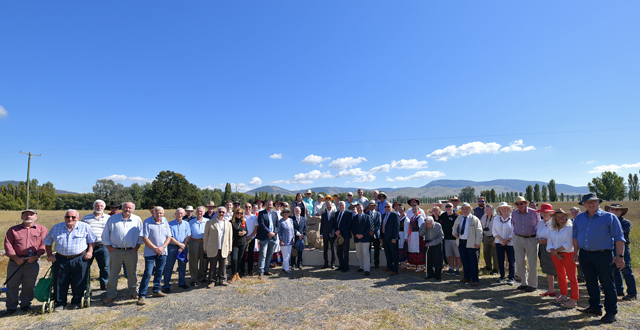
Unveiling Strzelecki Plaque at Welaregang, March 9th, 2021 |
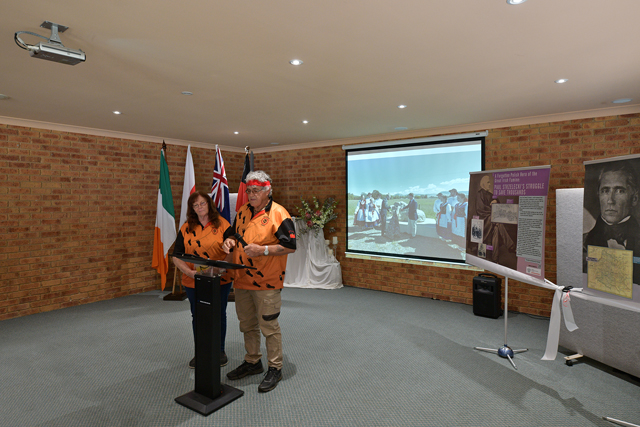
Welcome to Country by Uncle John Casey and his wife. Celebrations at Tumbarumba after unveiling Strzelecki Plaque at Welaregang |
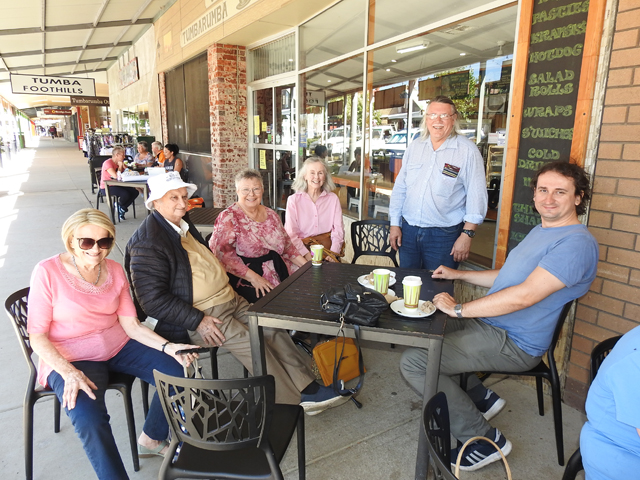
Tumbarumba March 10th 2021, meeting George Martin and Ted Golian |
And here Polonia inadvertently got trapped. First of all, it should be realized that until 2019, no formal procedure demanding a double name of the Mountain or its change had ever been launched. The Kosciuszko National Park Management Plan of 2006 contained a recommendation for dual-naming, but however dangerous it was, it was a general recommendation and not explicitly directed against Polonia, Strzelecki, Kościuszko or the Mountain. Therefore, any protests by the Polish community could be and were treated as media hype. Likewise, the George Martin speech of 2000. Let us recall that the speech in 2006 before the Productivity Commission on the Conservation of Historic Heritage Places by Dr J. Rygielski, President of the RNPA, was summarized by the Chairman of the Commission, Dr. N. Byron:
I don't think that in the minds of the Australian government when they asked us to investigate this topic, they were thinking about the protection of historic place names. I understand your interest and the importance of the issue to the Polish community and I think it's a very interesting much wider question apart from just that one place name, but I'm still not sure what we can do about it.
President Rygielski obviously understood this important formal procedural aspect of the case, because in his article Should Mount Kościuszko serve everyone and every initiative? in 2009, he wrote the following about Paweł Gospodarczyk's fanfare in the Parliament of the Republic of Poland regarding the 2000 event.
The mayor's idea was accepted by the state of New South Wales (claimed by P.G.). Misunderstanding, the idea did not reach the level where it would require the approval of the NPW authorities. (J.R. wrote)
In 2007 new characters appear on the stage: Ernestyna Skurjat-Kozek, a retired SBS radio journalist who runs the Puls Polonii portal, and Urszula Lang, artistic director of the folklore group Lajkonik. Both ladies, together with the Australian amateur orchestra, Windjammers, managed to lead - with the consent and help of the Kosciuszko National Park Management - a Polish-Australian concert under the thought-provoking name ‘Kosciuszko Music on Mount Kosciuszko’.
Thus, innocently and with fantasy, a new positive era of relations began between the Polish-Australian community and the Kosciuszko National Park, together with local people and local authorities and later with the Ngarigo elders, the traditional custodians of Mount Kościuszko. A seven-year cycle followed of Kosciuszko Festivals in Jindabyne and Cooma with competitions and concerts aimed at promoting goodwill and information about Kościuszko, Strzelecki and Mountain, as well as about Polish culture. There were meetings, workshops, and mutual participation in celebrations culminating in the year of Kościuszko 2017 with the historic visit of the Ngarigo delegation to Kościuszko Mound and the Wawel Castle in Kraków.
We were well aware that for the Polish community media discussion or letters addressed to the wrong offices in the form of arguing about the name of the Mountain was another counter-productive strategic trap. Failure to maintain friendly relations with the Kosciuszko National Park is a mistake. Good intentions and good will, not complaints to offices or officials. You have to try to understand how the Australian environment in which we live works. By building positive relationships the Polish community connections with Mount Kościuszko were placed on the National Heritage List. Likewise Ms Heney's false entries in Strzelecki's biography were corrected. If we, as Polonia, want to be a partner in the discussion, we must be constantly present in the Mountain region. If the time comes for talks or discussions, including discussions about changing the name of the Mountain, the Polish community must be a stakeholder present in the region, and at all times part of the discussions, consultations and exchanges of information on such issues.
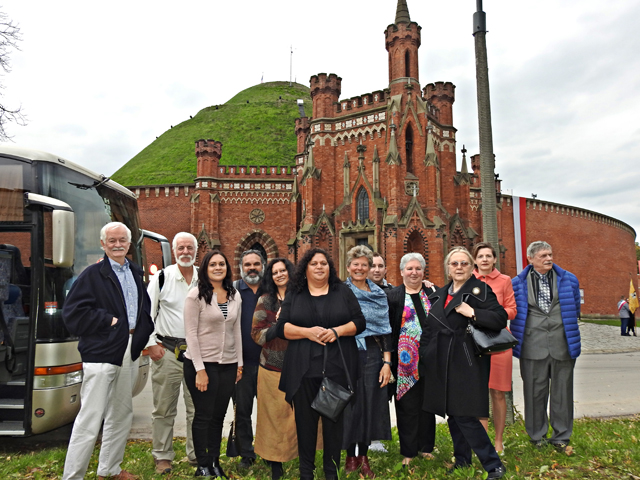
Kosciuszko Mound, Kraków, October 13th 2017, Australians and Americans attending Kosciuszko International Conference |
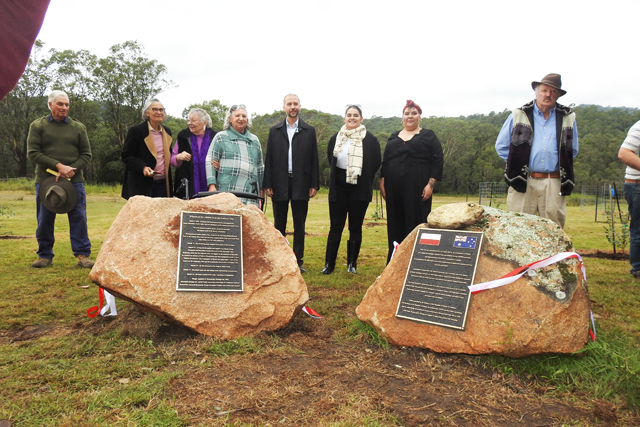
Geehi, April 4th 2022, Ambassador M. Kolodziejski (centre) flandek by Aunty Iris White, Tanaya Edwards and Aunty Sally Lavallee (Monaro Ngarigo). Unveiling two commemorative plaques. |
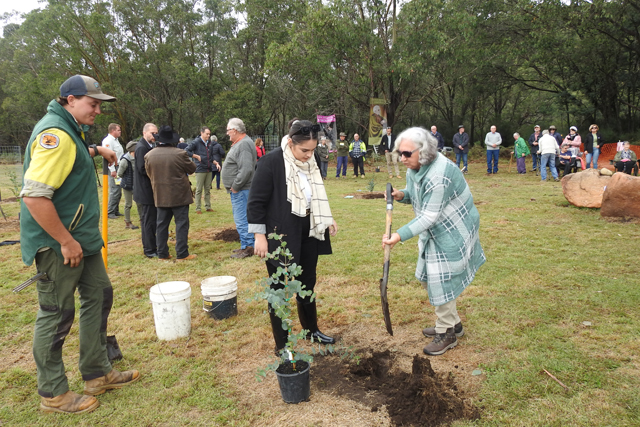
Geehi, April 4th, 2022, Aunty Iris and Tanaya Edwards (Monaro Ngarigo) planting commemorative trees on the 50th anniversary of Polish & Australian Diplomatic Relations |
On the other hand, media discussion is the worst method of solving problems, almost impossible to control. Through released emotions it provokes extreme actions. Being on a ‘war path' with Aboriginal people never makes sense, it would be betraying Kościuszko's ideas and his famous Will nor will it ever bring glory to us - neither as Polonia nor as Poles. Both sides have their closely held cultural values, which, despite conflicting priorities, can be solved through compromise. Ngarigo want to promote their art and culture, of which they are as proud as we are of our Pol-Art. We can help them with this, because international recognition is valuable to them in the face of frequent local ambivalence. But this requires getting to know each other first, making friends and understanding the values of each that are dear to the other.
The celebration of the 70th anniversary by the Polish Community Council of Australia (PCCA) did Polonia a disservice. It exposed the previous counter-productive ‘war path’ approach of Polonia against Aborigines during the 2000-2006 period. At the same time, the cooperation between Polonia and the Traditional Custodians of Mt Kosciuszko after 2007 was ignored and even hidden from the Polish diaspora. In 2007 and later difficult matters were solved differently and more effectively. Sadly, it seems that it is the counter-productive approach that the Presidium and its acolytes still want to permanently inflict on their enslaved part of Polonia. Like on a flock of mindless sheep. But who does such an image of a Polonia serve? It is most doubtful how effective such a model will be.
ANDRZEJ KOZEK, VICE-PRESIDENT OF KOSCIUSZKO HERITAGE INC.
This article was written by A. Kozek just before his trip to Poland along with Monero Ngarigo delegation; was translated by Felix Molski a bit later and was stranded unpublished in Puls Polonii until now (June 12th 2023) for several serious reasons including unexpected health condition of Ernestyna.Can we please be forgiven for this delay.
Ps. Of course, KHI didn't, doesn't, and can't work by itself. The support of the Polish community was, is and will be essential for our activities. In this article, I focused on presenting our strategy, which would not be possible to implement without the Polish community. I am sorry that I do not list here hundreds or (in total) thousands of participants in our projects. Without you there would be nothing. Despite the differences in our approach to Mount Kościuszko issues, I appreciate the work, knowledge and commitment of all those who, in my opinion, defended the name of the Mount and acted with the best intentions. In the achievements of KHI, I do not include 'defending the name of the Mountain', because that is not our main goal. I believe that in cooperation with the traditional custodians of the Mountain, the name will defend itself, but let it be a side effect of our relations. And another trap faced by the Polish community in Australia is the glory seeking auction of who has done more, who is more important and who has been omitted.
Dr Ernestyna Skurjat-Kozek has collected a lot of intriguing information related to the death of P.E. Strzelecki. In particular, it is not clear whether his papers were actually burned, as stated in the latest version of his will.
Although they were related to the Aboriginal tradition, they were not related to the Ngarigo, the traditional custodians of the Mountain, and had nothing to do with the history of the Mountain region.
Today, we know more about the naming of the Mountain than in the 19th century, and so far, the indigenous name of the Mountain has not appeared. The names so far proposed for dual-naming were invented each time, just to have something to do with the indigenous culture.
Some related links:
November 27, 2011 Kosciuszko - a bandit?!
October 14, 2008 Red-white flowers on Mt Kosciusko (1967) by Tomasz Ostrowski
August 16, 2009 Should Mount Kościuszko serve everyone and every initiative? by
Janusz Rygielski
September 20, 2009 Tumba Trek 2000, Why did the Polish ambassador get away?
May 15, 2019 Kosciuszko fight. Maybe this silence is a good sign? by Ernestyna Skurjat-Kozek
May 27, 2019 Biography of former Tumbarumba Mayor George Martin by Ernestyna Skurjat-Kozek
Robert J. L. von Lendenfeld - Wikipedia
|


